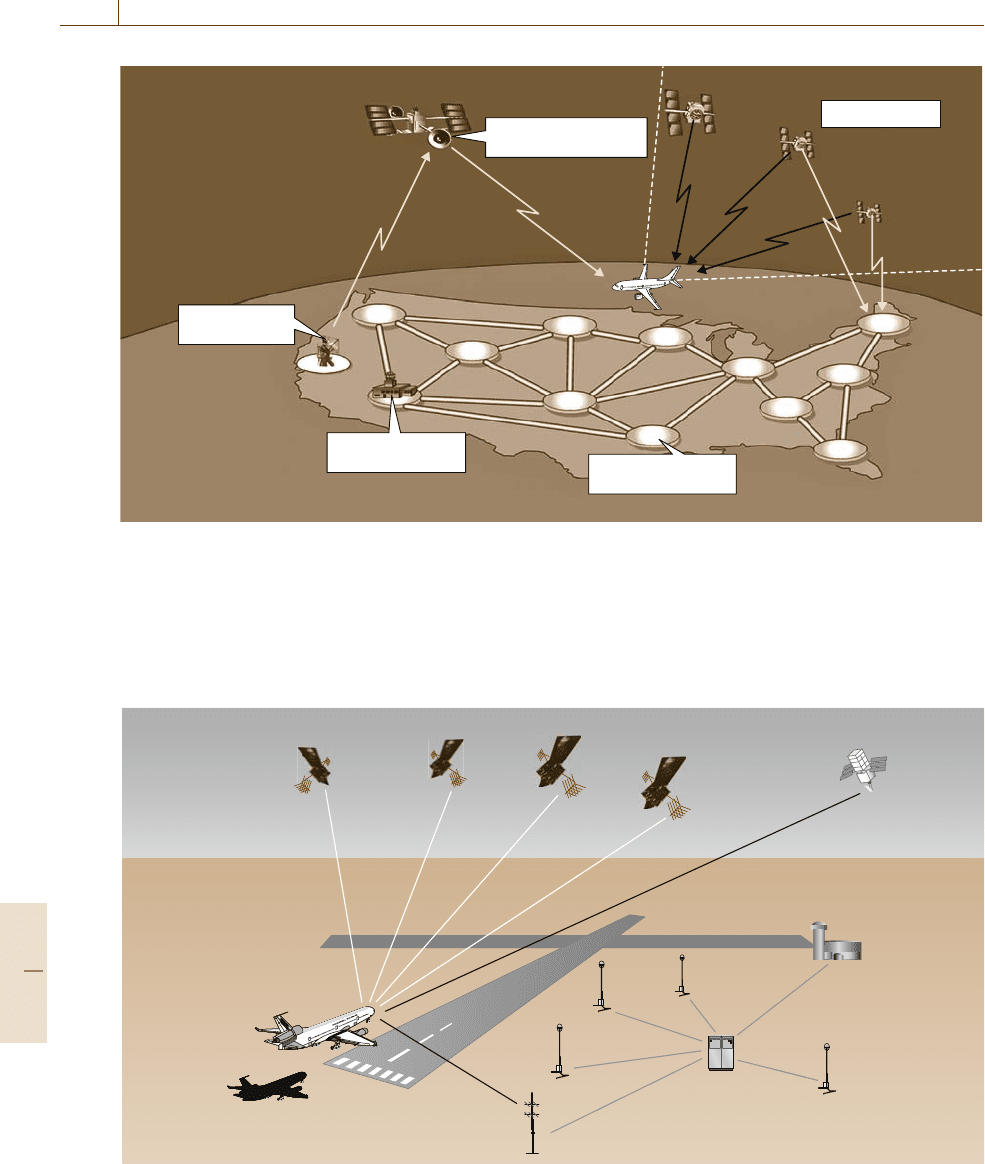Nof S.Y. Springer Handbook of Automation
Подождите немного. Документ загружается.


Air Transportation System Automation 67.1 Current NAS CNS/ATM Systems Infrastructure 1185
(67.1), that governs the radio line-of-sight distance (D)
from the aircraft to the radio horizon
D = K
√
h , (67.1)
where D =distance (in nautical miles), h = height (in
feet) of the aircraft station, and K = 1.23, a constant
corresponding to an effective Earth’s radius of 4/3of
the actual radius.
These voice channels either support a single op-
erational AT C position on a specified control fre-
quency, providing half-duplex party-line communica-
tions among the controllers and the pilots in a specific
airspace, or provide one-way broadcast information for
weather or traffic conditions on designated informa-
tion frequencies, as shown in Fig.67.3. Air-to-air and
emergency frequencies are also specially provisioned
for in the VHF band. A continuously monitored emer-
gency frequency has been established worldwide at
121.50MHz, and an air-to-air channel has been desig-
nated for use at 123.45MHz.
Beyond today’s voice communications, digital tech-
nologies are used fordata linksin theAT C environment,
allowing for data communication from an automated
ATC system, that can closely integrate and incorpo-
rate directly with the aircraft systems. One of the first
aeronautical communication data links to operate was
the aircraft communications addressing and reporting
system (ACARS) introduced in the late 1970s. The
ACARS operates at 2.4kbps, and provides short mes-
sages indicating aircraft on, out, off, in (OOOI)events
relating to the aircraft leaving the gate, taking off, land-
ing, and arriving at the gate, to help airlines manage
their aircraft. This system also operates in the VHF
band, and has been expanded to include more ap-
plications, including a predeparture clearance (PDC)
function for ATC and a digital broadcast automated ter-
minal information service (ATIS). Succeeding ACARS,
a digital link, called VHF digital link (VDL) mode 2,
was defined and standardized through the ICAO,topro-
vide more capacity and higher speed (31.5kbps) for
airline and AT C operations. Other data link systems that
have also been defined and standardized through the
ICAO include:
•
VDL mode 3, which integrates a digital AT C voice
capability with the data link
•
VDL mode 4, which can also provide surveillance
functions
•
Mode-S data link, which integrates data commu-
nications with the surveillance information such
Controlled
airspace
Control
frequency
Information
frequency
Air/air
frequency
Fig. 67.3 VHF communications environment
Fig. 67.4 Worldwide SAT COM use in AT C – shaded in green
as from automatic dependent surveillance-broadcast
(ADS-B).
In the 1990s, worldwide satellite communications
networks for aviation first became available through
the commercial satellite service providers, including
Inmarsat and Iridium. Satellite communication is dis-
placing the long-range HF voice communications for
ATC in many areas of the world and is also providing
reliable long-range data links in low-density air traf-
fic environments, such as oceanic airspace as shown
shaded green in Fig.67.4.
New air/ground communications capabilities will
provide faster and greater information sharing among
ATC systems and aircraft using the above technologies,
thereby improving the safety and efficiency of air traffic
operations.
Part G 67.1

1186 Part G Infrastructure and Service Automation
As new digital radio communications systems
enable aircraft’s control processors to coordinate in-
formation with the ground control systems, radio
communications will become an even more critical
component of managing air traffic control.
The air/ground communications system is a criti-
cal component of the ATM system, because it provides
aircraft control information (e.g., instructions and clear-
ances to the aircraft) and in some cases feedback
information (e.g., aircraft position to the ground) to al-
low safe and efficient transit of air traffic through an
airspace. Depending on the operational environment
and specific equipmentbeing employed, other functions
and information can be provided over the communi-
cations systems, such as broadcast information to the
pilots on local terminal weather conditions and run-
way operations, meteorologicalinformation for weather
models or pilot-reported turbulence information. Given
the ability ofan aircraft to operate anywhere in theNAS,
the systems on an aircraft must be able to interface with
the ATM system, and the pilots must interact with the
ATC system wherever they fly.
67.1.2 Navigation and Guidance Systems
Until recently, the VOR/DME or the VOR tactical air
navigation (TACAN)(VORTAC) system has been the
primary guidance system for navigation. Because of
its line-of-sight limitation, the VOR/DME navigation
is not available everywhere in the NAS, especially in
remote mountain, polar, and oceanic regions. With the
availability of broadcast signals from Earth-orbiting
satellites as a part of global positioning system (GPS),
ILS transmitters
Glide slope
antenna
Localizer
antenna
Middle
marker
Outer
marker
Fig. 67.5 Instrument landing system (ILS)
aircraft equipped with GPS receivers can navigate
point-to-point anywhere.
VOR/DME Navigation Systems
The VOR/DME [67.5, 6] is a short-range navigation
system that has been internationally standardized and
is in use throughout the world. To achieve a common
civil–military system for en route navigation in the
US, the distance measurement element of VOR/DME
is provided by the military tactical air navigation
(TACAN) system. The collocation of VOR and TACAN
constitutes a VORTAC ground facility, providing VOR-
bearing information to civil users, the TACAN-bearing
information to the military aircraft, and distance in-
formation to both. At present, there are 775 VORTAC
facilities in the US, 145 VOR/DMEs, and 90 VOR-only
ground stations. A few more VOR ground stations have
been procured by individual organizations that add to
the total number of VORs listed above.
The VOR system has been the standard air naviga-
tion system to provide aircraft with bearing information
with respect to a ground station. The VOR ground
station transmission is in the VHF band from 108 to
117.95MHz, divided into 50kHz channels modulated
by a 30Hz signal and by a subcarrier of 9960Hz, which
is frequency-modulated (FM) at 30Hz. The phase of
the two 30Hz signals is adjusted such that the phase
coincidence occurs at magnetic north.
The VOR receiver employs a simple superhetero-
dyne front-end followed by an envelope detector and
narrow-band filters to separate the individual signal
components. The FM signal is demodulated to recover
the 30 Hz signal, and the two 30Hz signals are applied
to a phase comparator. The phase difference between
these signals corresponds to the magnetic bearing of the
aircraft from the ground station. A course selector (i.e.,
phase shifter) is added to one of the inputs to the phase
comparator to permit the pilots to select any desired
bearing between 0 and 360
◦
.
The DME system is an electronic range measur-
ing system which provides slant range information
to the aircraft. DME is a two-way ranging method
with a ground station operating as a transponder. The
airborne interrogator transmits pulse pairs at a given
ground station frequency and pulse-pair spacing. The
ground station detects the presence of the pulse pair
when it exceeds some detection threshold. The time of
detection of the half-voltage point on the first pulse is
used as a time reference for reply. A fixed 50 μs delay
is introduced to account for internal delays. This delay
can also be used to provide an electronic offset of the
Part G 67.1

Air Transportation System Automation 67.1 Current NAS CNS/ATM Systems Infrastructure 1187
DME zero range. The reply pulse pair is translated in
frequency by 63MHz. The interrogator determines its
slant range by measuring the time between transmission
and reception. The interrogator’s transmissions are ran-
domized to permit separation of its range data from that
of the other interrogators.
Instrument Landing Systems
The ILS is a radio navigation system that provides
an equipped aircraft with the horizontal and vertical
guidance required for conducting precision landing ap-
proaches to the runways in lower-visibility conditions.
As shown in Fig.67.5,theILS consists of two direc-
tional transmitters with a localizer and a glide slope
aligned with the runway centerline. The horizontal
guidance is provided by a VHF band localizer and the
vertical guidance is provided by an ultrahigh-frequency
(UHF) band glide slope transmitter. The distance infor-
mation is provided by the DME, or by low-frequency
(LF) marker beacons located at a certain distance from
the runway end (threshold), as shown as middle and
outer markers in Fig.67.5.IntheNAS, there are ap-
proximately 715 airports capable of providing precision
instrument approaches. There are three categories of
ILS equipment used under different levels of visibility
conditions, depending upon when the pilots can see the
runway (lights) from a certain height above the ground,
called the decision height:
•
Category I: Visibility minima as low as 1/2 statute
mile within 200ft (60m) height above touchdown
•
Category II: Visibility minima as low as 1/4 statute
mile within 100–199ft (30–60m) height above
touchdown
•
Category III: Visibility minima potentially as low
as zero feet within 0–99ft (0–30m) height above
touchdown.
Although the ILS hasproventobeasafeand
effective landing aid worldwide, the technology has
a number of limitations. First, it is relatively expen-
sive to purchase and installthe equipment.The antennae
require large clear areas free of metal or metallic re-
flections, i.e., aircraft taxiing on the airport must be
restricted in their position in order to avoid interfer-
ence with the ILS signal. The ILS equipment must be
routinely checked in flight to ensure that it meets the
required specifications.
Satellite Navigation Systems
There are currently two satellite navigation constella-
tions: the US GPS and the Russian global navigation
satellite system (GLONASS), although only GPS is
widely used outside of Russia. The implementation
of the third and fourth constellations, GALILEO and
COMPASS are currently being planned by the Eu-
ropean Union and China respectively. Only GPS is
discussed in this section, since it is the only operational
system widely used by civil aviation.
Each satellite from these constellations continu-
ously broadcasts a signal that carries ephemeris infor-
mation allowing an accurate calculation of the satellite
position and a code allowing for the accurate measure-
ment of the signal propagation time from the satellite
to the aircraft. A suitably designed receiver can acquire
and track this signal and use the broadcast informa-
tion, as well as so-called pseudorange measurements
derived from the signal propagation time, to compute an
accurate position solution every second. Such position
solutions, however, do not meet all aviation require-
ments because their integrity is not assured. Integrity
is a measure of trust in relying on the accuracy of the
navigation system information, where the system alerts
the user when the system is unable to contain the posi-
tion error within an acceptable limit for safe operation.
Several forms of augmentation have been developed
in order to obtain the integrity required for aviation.
Forms of augmentation that are currently used include
a receiver-based technique called receiver autonomous
integrity monitoring (RAIM) or aircraft-based augmen-
tation system (ABAS), which uses redundant informa-
tion from the number of satellites in view to ensure
the integrity of the position solutions. Two other aug-
mentation systems are the satellite-based augmentation
system (SBAS) and the ground-based augmentation
system (GBAS). Each system uses a ground infrastruc-
ture to derive corrections and integrity bounds for the
satellite signals. The SBAS and GBAS differ in the
type of correction and integrity information, as well as
the means used to communicate that information to the
user receivers. The SBAS is intended to provide service
over wide areas and broadcasts the information from
the geosynchronous satellites. The GBAS is intended to
provide service over terminal areas by broadcasting the
information from VHF ground transmitters. A hybrid
augmentation system called ground regional augmen-
tation system (GRAS), currently being developed in
Australia, provides navigation service over wide areas
using a network of VHF ground transmitters.
There are three main types of aircraft receivers for
GPS and augmentations. These receivers provide po-
sition solutions to other parts of avionics, such as the
flight management system (FMS)andthenavigators,
Part G 67.1

1188 Part G Infrastructure and Service Automation
GPS satellites
GPS
WAAS
Communication satellite
(with WAAS transponder)
Ground Earth
stations
Wide-area
master station
Wide-area
reference station
Correction terms,
integrity data
GPS-like
signals
Fig. 67.6 The wide-area augmentation system (WAAS)
which include displays and controls that provide navi-
gation guidance information to the pilots. Certified air-
craft GPS receivers with RAIM can be used for en route
navigation, terminal area navigation, and nonpreci-
sion approaches for landing operations. In addition,
Navigation satellites
SBAS signal
(ranging source only)
SBAS satellite
GPS satellites
Ranging sources
GBAS
reference
receivers
Status
information
VHF data broadcast (VDB) signal
differential corrections, integrity
data and path definition data
GBAS ground
facility
Fig. 67.7 The local-area augmentation system (LAAS)
the SBAS aircraft receivers can be used for vertically
guided approach and landing operations, called the pro-
cedures with vertical guidance (APV) approaches. The
primary APV in the USA is the localizer performance
with vertical guidance (LPV) approach. GBAS aircraft
Part G 67.1

Air Transportation System Automation 67.1 Current NAS CNS/ATM Systems Infrastructure 1189
receivers can be used for category I precision approach
operations in addition to the terminal area navigation.
The SBAS uses a network of ground stations to
receive GPS signals. The signals are forwarded to
a master station, where atmospheric and other errors
are identified, and a grid of corrections is created. This
grid is transmitted tothe user througha geosynchronous
satellite. The user receiver can then interpolate be-
tween the corrections and improve the accuracy and
integrity (i.e., the assurance, within specifications, that
the navigation position is free from error) of the GPS
signal. US operations use a wide-area augmentation
system (WAAS), which can provide corrected horizon-
tal and vertical guidance throughout the USA and parts
of Canada and Mexico. WAAS was commissioned in
2003. A schematic of WAAS is shown in Fig.67.6. The
Japanese have developed the multifunction transport
satellite (MTSAT) satellite-based augmentation system
(MSAS), which is an SBAS that provides coverage in
the Asia–Pacific region. Similarly, the European Union
has developed the European geostationary navigation
overlay service (EGNOS) that provides SBAS cover-
age over Europe and Africa. MSAS was commissioned
in 2007 and EGNOS is expected to reach initial oper-
ational capability in 2009. The Indian government is
developing the GPS and GEO augmented navigation
(GAGAN) system, which will provide SBAS coverage
over theIndian subcontinent. All of theseSBASs arebe-
ing developed under common international standards,
so the receivers will be able to use any one of these
systems.
The GBAS uses a ground station located on or near
the airport to receive the GPS signals and to correct
for errors. The correction information is forwarded di-
rectly to the aircraft via a VHF data link. The US GBAS
system is called the local-area augmentation system
(LAAS) and is shown in Fig.67.7. Since the GBAS
or LAAS station is located on the airport and near the
approach path, there is no interpolation required. The
LAAS may have the potential to provide category III
service for the approach and landing, while the WAAS
will be restricted for landing guidance to category I ser-
vice. Air Services Australia is also developing a GBAS
for certification in 2009.
67.1.3 Modes of Navigation
VOR/DME Mode of Radial Navigation
There are three types of VOR/DME facilities in the US.
The difference among the facilities is related to the vol-
ume of airspace around each facility that is protected
from interference from another facility. This airspace is
known as the standard service volume (SSV). The three
types are listed below:
•
Terminal (T): 25nmi radius from 1000 to 12000ft
•
Low (L): 40nmi radius from 1000 to 18000ft
•
High (H): 40 nmi radius from 1000 to 14 500ft,
100nmi radius from 14500 to 18000 ft, 130nmi ra-
dius from 18 000 to 45000 ft, 100nmi radius from
45500 to 60000ft.
Coverage below 1000ft is defined for reduced radii
that are altitude dependent. Only H and L facilities
are used for en route navigation. All facilities may be
used for terminal area maneuvering and nonprecision
approaches. Within the SSV, the pilots are assured of
a signal with adequate power protected against interfer-
ence from other facilities transmitting on the same or
adjacent frequencies.
The present NAS en route navigation procedures for
a majority of aircraft involve flying along VOR radials
in or out of the ground station. The low-altitude victor
airways and the high-altitude jet routes are defined by
these radials like the highways in the sky.
Flights at or above 24000ft MSL are not authorized
without a DME whenever the instrument flight rules
(IFR) require VOR equipment (US regulations permit
substitution of an approved GPS receiver for a DME re-
ceiver in most cases). The DME equipment is installed
in most commercial aircraft and in a large percentage
of corporate and some general aviation aircraft. Smaller
aircraft flying at lower altitudes may not need a DME.
Also, many aircraft owners are replacingDME receivers
with GPS receivers.
Area Navigation (RNAV)
and Required Navigation Performance (RNP)
The RNAV mode of navigation permits aircraft with ap-
propriate equipment to fly any desired path from point
to point without the need to overfly ground stations
within the coverage of the station limits using either
VOR/DME or DME/DME guidance.
RNP provides additional assurance of adherence to
the desired navigation path. The US is planning to tran-
sition to full RNAV operations, with RNP operations
where beneficial.
DME/DME RNAV is considered possible in those
areas where the radii defining the DME arcs from at
least two stations intersect at an angle between 30 and
150
◦
. RNAV using DME/DME is more accurate than
RNAV using VOR/DME, particularly at long ranges.
The DME/DME-RNAV is feasible over most of the
Part G 67.1

1190 Part G Infrastructure and Service Automation
USA, although some areas will not have appropriate
coverage using DME/DME at some altitudes. Aircraft
using satellite navigation have service available over the
entire USA and can fly RNAV routes and procedures
anywhere in the USA.
Approach and Landing
The instrument approach procedures to a runway in-
volve landing during instrument meteorological condi-
tions (IMC), and allow the approaches to be abandoned
when a landing cannot be completed, such as when the
weather is too bad to land, another aircraft is on the run-
way, or some other reason. The instrument approaches
are generally divided into two categories: nonprecision
approaches, which have only horizontal guidance; and
vertically-guided approaches, which have both horizon-
tal and vertical guidance. In a nonprecision approach,
the aircraft flies along a published path and descends to
remain above the published minimum altitudes during
the approach. The aircraft uses its barometric altimeter
to determine theminimum altitudes.The lastsegment of
the approach is called the final segment. The final seg-
ment starts at the final approach fix (FAF), continues to
a missed approach point (MAP), and is usually aligned
with the centerline of the landing runway. The pilot is
required to see the runway visually prior to landing. For
a nonprecision approach, the aircraft departs the final
approach segment andflies alongthe publishedhorizon-
tal path. The pilot descends to the published minimum
altitudes. When the runway is in sight, the aircraft con-
tinues to land. If the runway is not in sight by the
MAP, then the aircraft executes a missed approach. Af-
ter a missed approach, an aircraft may attempt another
landing approach, or may proceed to an alternate air-
port. Nonprecision approaches can use VOR, NDB,or
the global navigation satellite system (GNSS), of which
the USGPS is currently the only operational component
for civil aviation.
For a vertically-guided approach, the aircraft de-
parts the final approach fix, but has a vertical and
horizontal guided path. Vertically-guided approaches
typically align the aircraft on a stabilized glidepath, and
allow the aircraft to continue on the stabilized path until
just before landing. The stabilized vertically guided ap-
proach is generally considered superior and safer than
the nonprecision approach, which often require vertical
maneuvering when the aircraft is near the runway, such
as after the runway has been acquired visually by the
pilot.
Studies have shown that the controlled flight
into terrain (CFIT) accident rates are lower for the
vertically guided approaches than for the nonpreci-
sion approaches. In addition, the visibility minima
for vertically-guided approaches are also generally
lower. This has led to a general desire to provide
vertically-guided approaches (both APV and precision
approaches) to all or most runway ends in the US.
Many commercial aircraft have GPS receivers
and sophisticated barometric vertical guidance sys-
tems. These aircraft can fly lateral/vertical navigation
(LNAV/VNAV)andRNP approaches, using GPS for
horizontal guidance and approved barometric verti-
cal navigation approaches for vertical guidance. The
LNAV/VNAV approaches do not have sufficient accu-
racy or integrity to meet Category I minima, but do
provide useful vertical guidance. The US has published
over 1577 LNAV/VNAV and 234 RNP approaches, pri-
marily to the runways serving commercial aircraft (as
of January 2009).
The augmentation systems discussed earlier have
the potential to provide vertically guided approaches to
more airports and runways at a lower cost. Currently,
an ILS must be installed on each runway end where
vertical guidance is desired. However, approaches us-
ing GPS/barometric vertical navigation, LNAV/VNAV,
or WAAS may be permitted without any ground navi-
gation infrastructure. In addition to the LNAV/VNAV,
the FAA is currently developing LPV approaches to
most instrument runways. The LPV approach is pri-
marily a WAAS vertically guided approach, and has
a requirement of visibility minima equivalent to an ILS
category I approach. The FAA has published over 1445
LPV approaches (as of January 2009), and plans to pub-
lish approximately 300 LPVs per year.
The LAAS system will use the GNSS landing sys-
tem (GLS) approach. The GLS approach is equivalent
to a category I ILS approach, but could also attain cate-
gory II and category III performance. One LAASstation
can serve each runway end at the airport, so there is
a potential for reducing the ILS infrastructure and sav-
ing costs with LAAS. The LAAS system has not yet
been commissioned, so no GLS approaches have been
developed at this time.
67.1.4 ATC Surveillance Systems
and Aircraft Tracking
ATC surveillance refers to the process of determin-
ing where aircraft currently are in a given volume of
airspace. Aircraft tracking refers to the process of cor-
relating successive measurements of various aircraft po-
sitions with the identified flights, thereby forming a his-
Part G 67.1

Air Transportation System Automation 67.1 Current NAS CNS/ATM Systems Infrastructure 1191
tory or track of positions, where each flight has recently
been. Time-averaging the successive changes in a given
aircraft’s track position yields an estimate of that air-
craft’s current velocity as well. Given the aircraft’s cur-
rent position and velocity, its next position can be pre-
dicted for the purpose of surveillance data correlation.
ATC Surveillance Radar Systems
ATC surveillance systems locate weather and aircraft,
which enable the ground controllers to separate aircraft
safely by providing pilots with surrounding aircraft and
weather advisory information. They involve both the
ground and aircraft components. Two types of systems
are currently used for aircraft surveillance:
•
Search or primary radar (radio detection and
ranging)
•
Beacon or SSR.
The primary radar is so called because it was the
first radar system developed and fielded for AT C. The
secondary radar was the second radar system devel-
oped and fielded, and is used as the major radar for
ATC surveillance today. Whenever the secondary radar
fails, the primary radar serves as a backup. The pri-
mary radar also fills in the coverage for secondary radar
dropouts. The primary radars detect two-dimensional
(2-D) horizontal position of aircraft by sensing radar
energy reflected from the surface of the aircraft. Al-
though the primary radars provide aircraft position in
terms of range and azimuth, other relevant data about
an aircraft’s identification and its altitude are not avail-
able. The primary surveillance is noncooperative, i.e.,
it detects aircraft position without the aid of an aircraft-
based transmitter/receiver unit, termed a transponder.
The primary surveillance systems are used to detect all
airborne objects, including aircraft with such failures as
loss of electronic power or failure of the transponder.
The secondary surveillance came about in an
attempt to overcome some of the limitations and
deficiencies of primary surveillance. The secondary
surveillance is cooperative, because it requires the
aircraft transponders in order to detect aircraft, to pos-
itively identify aircraft, and also to receive altitude
reports of aircraft, depending on the transponder mode.
The SSR requires the aircraft to be equipped with
a transponder. The SSR ground station transmits radio
frequency at 1030MHz pulses from a rotating antenna.
Upon receivingthe groundsignal, thetransponder trans-
mits a reply on a different frequency 1090MHz. The
aircraft range (ρ) and bearing (θ) are determined from
the time delay and radar antenna direction [67.7]. Most
airports and TRACONs in the USA use short-range
radar or an airport surveillance radar (ASR). These
radars provide surveillance coverage up to 60nmi and
30000 ft. The ARTCCs use air route surveillance radars
(ARSR), which have a range of about 200nmi and cov-
erage up to 60 000ft. A mode C transponder transmits
altitude information.
The digital terminal radars using monopulse tech-
nology are ASR-11 and mode select sensor (mode S),
and the en route ARSR are AT C beacon interrogators
(ATCBI-6). The terminal radars provide position infor-
mation updates every 4–5s, and the en route radars
update every 10–13s. Generally the primary radar and
the SSR antennae are collocated to detect 2-D aircraft
positions consistently. The primary airport surveillance
is provided by an airport surface detection equipment
(ASDE-3), and the secondary surveillance by ASDE-X
using multilateration techniques.
Ground Automation Systems and Functions
The en route and terminal automation systems convert
target position (ρ, θ) into Cartesian coordinates, and
correlate targets with the aircraft tracks. A track main-
tains state data for an aircraft across the radar scan
updates. The tracker derives additional data such as the
aircraft ground speed and heading for display. The ve-
locity (speed and heading) information is also used in
the aircraft track prediction, and by higher-level au-
tomation functions such as conflict alert (CA) and min-
imum safe warning altitude (MSAW), discussed later.
The trackscan be automatically or manually initiated by
the controller. AllIFR aircraftare requiredto filea flight
plan. When there is flight plan data available in the sys-
tem, a track is automatically associated with the flight
plan so that the flight data, such as the aircraft identifi-
cation, is included with the speed, heading, and altitude
in the displayed alphanumeric tag (in the form of a data
block on the controller’s display). If a target correlates
with a track, the target position is used to update the
position of the display symbol, which the controllers
use for aircraft separation. If no target information is
received in a scan, then the predicted track position is
used to update the aircraft position on the display.
The terminal automation system initially included
only single-radar displays, where all target data were re-
ceived from only a single controller-selected radar site.
The latest automation system upgrades provide a mo-
saic display selection to the controllers. The mosaic
partitions the surveillance area into a grid with differ-
ent cells assignable to different radar sites. The en route
automation system includes an ARTCC facility-wide
Part G 67.1

1192 Part G Infrastructure and Service Automation
mosaic display. The automation system processes dig-
itized radar weather messages and handles display
formatting. The map messages are converted into dis-
play messages with x, y coordinates, and transmitted to
the display channel along with the radar flight target
data for display.
67.1.5 Aircraft Tracking
The ground AT C automation system provides aircraft
position, velocity, and altitude information to the con-
trollers to help them ensure safe separation between
aircraft based on established separation minima. These
minima are based on the accuracy and frequency or
update rate of aircraft position data and altitude dis-
played to the controller. Moreover, each aircraft must
be positively identified and accurately displayed. The
NAS tracking system and the automated radar terminal
system (ARTS), as a part of en route and terminal au-
tomation systems, respectively, process radar position
inputs to track aircraft and display information to the
controllers.
The aircraft tracking function computes the position
and velocity of all tracked aircraft within the ARTCC’s
radar coverage, and provides the means for maintain-
ing identity information (in alphanumeric form) with
the appropriate search and beacon radar targets on the
radar controller’s display. Because of the cooperative
nature of ATC, flight plan information concerning the
planned route of flight, aircraft speed, altitude, and as-
signed beacon identity code are used in the processing
by this function. The current tracker used in both the
en route and terminal automation systems is a linear
α, β tracker. With the position update rates mentioned
earlier, the tracker lags in detecting positions accurately
during aircraft maneuvers. The future automation sys-
tem enhancements will include a seven-state interactive
multiple model (IMM) Kalman filter tracker including
x, y, z,
˙
x,
˙
y,
˙
z, and turn rateto improve accuracy of posi-
tion and velocity determination not only during straight
and level flight, but also during maneuvers.
The accuracy of position and velocity determina-
tion by the tracking function is crucial in maintaining
the desired separations between aircraft. Thus, in the
future, as the aircraft surveillance and tracking accu-
racy improve, they could support reduction of minimum
separation requirements, thereby not only helping to
maintain safety but also to increase airspace/airport ca-
pacity. The ongoing deployment of standard terminal
automation replacement system (STARS) uses a mul-
tisensor (instead of a single sensor in ARTS) IMM
Kalman filter tracker to significantly improve the accu-
racy of position and velocity estimation.
Automatic Dependent Surveillance-Broadcast
(ADS-B)
The radar systems discussed above provide indepen-
dent surveillance for detecting aircraft. In order to
enhance not only the accuracy of position/velocity de-
termination, but also to increase coverage NAS-wide
(current limitation of radars in remote/mountain areas
in the USA), the ADS-B system provides cooperative
surveillance by broadcasting the GPS-derived position
information once every second using onboard naviga-
tion equipment. The ADS-B broadcasts include aircraft
identification, position, velocity, and intent (future air-
craft positions) within 100nmi. Other aircraft equipped
with an ADS-B receiver can process and display the
aircraft in their vicinity on a display called the cock-
pit display of traffic information (CDTI). The ADS-B
receivers on the ground can also receive the aircraft
broadcast information. The large commercial aircraft
use a 1090MHz mode S extended squitter, and the
smaller high-end general aviation aircraft use a univer-
sal access transceiver (UAT) 978MHz for transmitting
ADS-B information. The aircraft and the ground sta-
tions receive information from all line-of-sight aircraft.
ADS-B is currently being used in the State of
Alaska, where there is limited radar coverage. Efforts
are underway to provide ADS-B information along the
US east coast from New Jersey to Florida. In spite of
higher accuracy and update rate, the use of ADS-B as
a single surveillance system haslimitations. Any loss of,
or errors in, the GPS signals could adversely impact the
aircraft detection. Therefore it is also necessary to con-
tinue using primary and secondary surveillance radars
complemented by ADS-B. The future automation and
tracking system will derive a unique single track for
each aircraft using ADS-B and radar measurements by
using data fusion techniques.
67.1.6 Air Traffic Management Functions
Traffic Flow Management
The TFM function is responsible for managing the NAS
airspace/airport capacity resources by efficiently bal-
ancing the demand for air traffic services with available
system capacity. The TFM monitors expected demand
to produce safe, orderly, and expeditious flow of traf-
fic to minimize delays due to congestion and adverse
weather. The ATCSCC has the authority to direct strate-
gic planning of TFM initiatives on a national basis, and
Part G 67.1

Air Transportation System Automation 67.1 Current NAS CNS/ATM Systems Infrastructure 1193
is the final approving authority for all regional interfa-
cility TFM initiatives. It has four key responsibilities:
•
Monitor air traffic demand, status of airports and
airspace, and forecasted weather across the USA
•
Coordinate with regional and local facilities to
plan and implement traffic flow constraints (aircraft
ground delays, ground hold/stops, altitude restric-
tions, rerouting etc.)
•
Assess NAS performance for long-term improve-
ments
•
Provide a central point of contact for the NAS users.
The TFM initiatives include:
•
For more than 6days in advance, plan strategies
to identify long-term system demands and airspace
choke points, as well as recommend operational and
procedural changes
•
From 6 days to 1day in advance, predict near-term
traffic loads and use weather forecasts to develop
strategies for balancing traffic demand and capacity
•
On the day of operations, analyze the impact of
planned constraints based on flight schedules and
predicted weather, as well as collaborate with the
users for dealing with the constraints and de-
mand/capacity imbalance
•
After the day of operations, analyze the archived
operations data to assess effectiveness of the traffic
flow initiatives.
The regional (ARTCC) and local (TRACON) TFM
functions deal with daily and hourly operations by bal-
ancing the demand with the predefined sector (segments
of airspace within the jurisdiction of each facility)
capacity.
As part of TFM automation, the enhanced traffic
management system (ETMS) provides NAS-wide in-
formation on traffic loads at capacity-limited resources
such as the airports, routes, route merge points (fixes),
and airspace sectors. The two components of the TFM
automation system are the traffic situation display,
which provides a map-oriented display for showing
aircraft positions, routes, and weather data, and the
monitor/alert function, which alerts when the traffic
demand in sectors or at fixes is predicted to exceed pre-
determined threshold values. A flight schedule monitor
provides capabilities to predict airport congestion, and
supports planning and monitoring of ground delays as
a part of ground delay program (GDP).
Air Traffic Control Services
The primary task of the ATC function is to safely guide
and separate aircraft flying under IFR, i.e., monitor
and maneuver aircraft to keep them separated by the
established separation minima and provide navigation
guidance in the airspace where there is no navigation
coverage. The following are specific clearances issued
by the controllers to service flights from gate to gate:
•
Taxi/runway assignment: when the aircraft is ready
to depart, the AT C function issues a clearance for
the aircraft to start taxiing on an assigned taxiway
and wait before the entry to the assigned runway
with a clearance to take off. Similarly the aircraft
are given landing clearances to specific runways.
•
Departure/arrival guidance: unless the aircraft are
capable of flying RNAV procedures from/to the air-
ports, the controller provides navigation guidance in
the airspace around the airport where there is no
navigation guidance available in the form of vec-
tors. These are compass headings that the pilots are
required to fly under ground system monitoring. In
addition, the controllers issue altitude changes and
speed adjustments to prevent conflicts by maintain-
ing the required distance spacings between aircraft
for safety. For departures, thenavigationguidance is
provided from radar contact (when an aircraft has
been positively identified on the radar display) until
the aircraft is able to navigate on its own. For ar-
rivals, the guidance is provided from the entry into
the terminal airspace, or from the termination fix of
a standard terminal arrival route (STAR), to the final
approach course for landing.
•
Separation from other aircraft: once the aircraft are
en route, the controllers ensure that each aircraft
is safely separated from all other aircraft in accor-
dance with the prescribed rules. When the desired
minimum separation is expected to be violated, the
controllers issue altitude/heading/speed clearances
to increase separation.
•
Safety alerts: controllers provide the aircraft with
low-altitude or obstruction warnings based on in-
formation provided by MSAW; wake turbulence
cautionary advisories, in case lighter aircraft are
following a heavy aircraft; and information on haz-
ardous weather, such as wind shear, using Doppler
weather radars and low-level wind-shear alert sys-
tem (LLWAS).
Part G 67.1

1194 Part G Infrastructure and Service Automation
67.2 Functional Role of Automation in Aircraft
for Flight Safety and Efficiency
As digital computers have become smaller, faster, more
powerful, and more robust over the past decades, air-
craft have benefited from their use in the cockpit to
automate key functions. In the late 1970s and early
1980s, for example, automation was aimed primarily
at reducing the pilot workload of managing complex
aircraft systems such as electrical, hydraulic, fuel, and
pressurization. This led to the elimination of the flight
engineer position in the aircraft. Automation in modern
aircraft has been effectively applied to enhance flight
safety and efficiency. Although the enhanced ground
proximity warning system and the predictive wind-
shear detection system alert the pilots to stay away from
the terrain and dangerous weather conditions, the traf-
fic alert and collision avoidance system (TCAS)isthe
most significant capability in the cockpit for warning
pilots about the presence of other aircraft in the vicinity.
The TCAS has its hardware and software integrated
with the other systems in the aircraft cockpit. Its pur-
pose is to avoidmidair collisions,acting as a last-minute
safety net when normal aircraft separation measures
have failed. The TCAS issues radio interrogations that
query ATC transponders carried onboard most aircraft.
Measuring the time of the replies enables the calcula-
tion of each aircraft’s slant range. The tracking of an
aircraft’s slant range every second yields the aircraft’s
closure rate. The reply also provides the aircraft baro-
metric altitude, which can be compared to that of its
own.
There are two different versions of TCAS for use on
different classes of aircraft. The first, TCAS I, indicates
the bearing and relative altitude of all aircraft within
a selected range (generally 10–20miles). With color-
coded symbols and aural alerts, the display indicates
which aircraft pose potential threats. This constitutes
the traffic advisory (TA) portion of the system. TCAS I
does not offer solutions to resolve the conflicts, but does
supply pilots with important data so that they can de-
termine the best course of action. The determination of
a potential collision threat is time based, rather than
based on a fixed distance, as is used by the ground
automation functions. The calculation of the time to
potential conflict τ is given by
τ =
−(r −k
2
/r)
˙
r
,
(67.2)
where r is the tracked range,
˙
r is the estimated relative
divergent range rate, and k is a constant for a given al-
titude. Another time calculation is used for the vertical
plane.
TCAS uses a modified τ, which predicts the time to
a specified minimum distance. This distance allows for
some lateral acceleration, without which TCAS could
provide inadequate warning time.
In addition to a traffic display, the more compre-
hensive TCAS II also provides pilots with vertical
resolution advisories (RA) when needed. The system
determines the vertical profile of each aircraft dur-
ing climbing, descending, or level phase of flight. The
TCAS II then issues an RA advising the pilot to exe-
cute an evasive maneuver necessary to avoid the other
aircraft in the form of climb or descend,orlimiting ver-
tical rates. If both aircraft are equipped with TCAS II,
then their systems coordinate toensure compatibleRAs.
As the cost of fuel has risen, automation is also used
to enhance the efficiency offlight operationsby employ-
ing thrustand energy state management techniques.The
FMS on a modern transport-category aircraft takes in-
puts from a wide range of sensors, and couples these
with data from a comprehensive navigation and flight
performance database. The FMS then generates an op-
timum flight profile in order to achieve the operator’s
objectives of minimizing direct operating costs, which
are made up of flight time and fuel-related costs.
The FMS includes a flight management computer
system (FMCS) coupled with a flight guidance system,
a thrust management system, and an electronic flight
instrument system (EFIS) to provide total flight man-
agement capabilities. The FMCS consists of two flight
management computers (FMC) and multiple control
display units (MCDU) to provide pilot interface for data
entry/review. The FMC provides flight planning and
performance management, navigation database storage
and retrieval, precise navigation and guidance, and in-
terface with other aircraft systems. Using the current
computed vertical profile data from the performance
function, the guidance function compares actual and
desired altitude and altitude rate, and generates pitch
and thrust commands as input to the flight guidance
and control (autopilot) and thrust management systems,
respectively. These systems include autopilots,flight di-
rectors, and an autothrottle. Each autopilot uses a flight
control computer (FCC), which signals movement of
aircraft ailerons and elevators. The autopilot captures
and holds the selected altitude when in vertical speed,
altitude change, or vertical navigation mode. The au-
Part G 67.2
